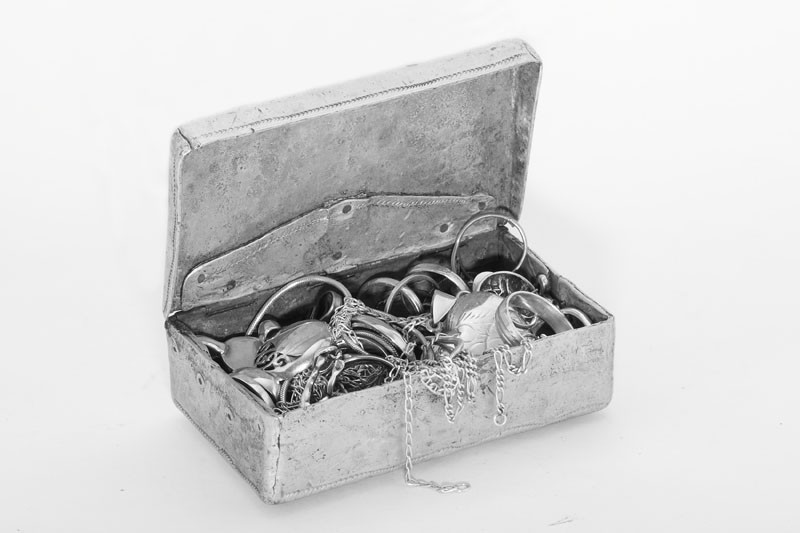Calm Before A Silver Storm

(December 15, 2019 - Mullan, Jennifer Passaro)
Six thousand, four hundred feet beneath the earth’s surface, Scott Hogamier and Jason Chambers ran a bolter in the gray rock, repeating an intricate process they know well. Combined with mesh lacing, the bolts retain rock while miners work in the Lucky Friday mine.
Over the past few weeks, the pair mucked out hundreds of feet of argillite and siltite. In 43 feet they’d make the 52-ramp connection, providing access to the rich galena vein on the other side.
“This drift is the best work in the mine,” said Clay Alexander, general manager of the Lucky Friday mine.
More than 3,000 feet below sea level, it was 92 degrees with 100 percent humidity, hot enough to make sweat run down the men’s faces. Humid enough to feel as though a tropical beach had suddenly replaced Idaho’s snowy shores.
“All these sediments were on the bottom of the ocean at one point,” said Larry Radford, Hecla Mining Company’s retired senior vice president and chief operating officer. “So we are [at the beach] in a way.”
Everybody chuckled and eyed the hard rock overhead.
Ever since United Steelworkers Union 5114 employees went on strike, supervisors and salaried employees have left their above-ground desks to run the machines underground.
“We’ve got geologists working as hoistmen, surveyors driving ore trucks, engineers mucking out stopes,” Alexander said.
The mine slowed without union employees. Production was down to almost 20 percent of what it was prior to the nearly three-year strike.
Chasing a dark vein of lead and silver on the 6,400-foot level, Anton Marek drilled “breast up rounds,” or 9-foot holes into the working face of 16 stope. The holes were filled with emulsion explosives and blasted. Marek worked deftly, with over 14 years experience, toggling the control of a single boom jumbo machine. Cameron Erickson helped him; miners always work in pairs.
Training supervisor Cliff Shiner coached Erickson, teaching him how to work with the geology of the mine. Shiner’s spent 31 years underground.
“You got a hanger bolt there,” Shiner said, pointing to a loose bolt in the stope.
Hecla hopes to replace the massive drill Marek was running with equipment from Swedish manufacturer Epiroc. The new machine, called “mobile miner” or “remote-vein miner,” will get miners farther away from the rock face while they work, increasing safety and simplifying the process, according to Alexander.
“The level of complexity we deal with hour in and hour out is different from any other job,” Radford said.
Alexander explained the current process. Miners drill the rock face, load the holes with an emulsion explosive, dynamite when the mine is empty, scale down dangerous rock slabs after the blast, muck the ore, bolt the new “ribs and back,” and begin the whole process over again, chasing a vein until it terminates.
“The Lucky Friday way is bolt, muck, drill, blast,” Radford said.
“I can tell the time of day by where I am in this process,” Chambers said. In this way the mine keeps its own time.
A vein is darker than the surrounding rock. It is the pulse of the mine, the reason the whole operation exists.
In 2016, Coeur d’Alene-based Hecla Mining Company sunk the #4 shaft at Lucky Friday to a final depth of 9,587 feet below the earth’s surface, making it the deepest operating hard rock mine in the United States. Hecla anticipated the shaft will feed silver, lead, and zinc to the surface for 20 to 30 years.
Ore trucks hauled 12-14 tons of muck — mineral-rich rock and host rock — to the automated and continuously running #4 shaft. The muck was carried to the surface to be processed in an onsite mill. The mill swirled around itself, a complex choreography of equipment, covered in dust from the underground.
Raw ore runs through the “jaw-crusher” and then a series of machines until it resembles buckwheat flour. A vast series of chemical cells eventually distill the silver, lead, and zinc from the rock powder.
“Everything is dynamic,” Alexander said. “We are constantly making adjustments in order to recover the most value.”
The tailings are mixed with concrete and used as backfill in the stopes where they originated.
The silver, lead and zinc concentrates are trucked to a smelter in Trail, British Columbia, where they’re refined into bars and sold on the market.
Back on the 5,900-foot level, Radford and Alexander waited for the hoistman at the shaft entrance with a handful of other miners. One thousand feet above them the booster fans that cool the mine and provide critical ventilation echoed in the rock tunnel like a jet engine stuck inside a cathedral. The fans exhaust 240,000 cubic feet of hot water vapor per minute to the outside world, keeping the air underground breathable.
The mine tunneled away from the shaft. Miners hopped on their buggies and disappeared, taking their light with them. Somewhere deep in the 16 stope, their tools resounded against the earth’s interior.
At the shaft, the miners circled stories of the mines they worked before Lucky Friday.
“The mining industry is a pretty small group,” Alexander said. “Especially underground.”
The group stepped into shaft, secured the doors, and rang the hoistman. The 5,900-foot level disappeared as they rode toward the surface. The darkness was complete, surged with cold air. Everyone paused, waiting for the surface.
With Friday, Dec. 13 the deadline for miners to approve or reject a new contract and settle the strike, perhaps another wait is almost over.






